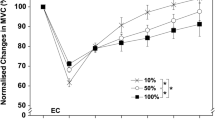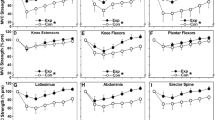Abstract
This study investigated the time wise protective effect conferred by two maximal voluntary isometric contractions (2MVCs) at 20° elbow flexion on muscle damage induced by 30 maximal isokinetic (60° s−1) eccentric contractions of the elbow flexors (MaxECC). Sixty-five young untrained men were randomly assigned to a control group that did not perform 2MVCs, or one of four experimental groups (n = 13 per group) who performed 2MVCs either immediately (0d), 2 (2d), 4 (4d) or 7 days (7d) before MaxECC. Changes in maximal isokinetic (60° s−1) concentric torque (MVC-CON), optimum angle (OA), range of motion, upper arm circumference, muscle soreness, plasma creatine kinase activity and myoglobin concentration, and ultrasound echo-intensity following MaxECC were compared among the groups by a two-way repeated measures ANOVA. No significant changes in any variables were evident following 2MVCs. The 2d and 4d groups showed 16–62 % smaller (P < 0.05) changes in all variables following MaxECC than the control, 0d and 7d groups. The 2d group showed 14–34 % smaller (P < 0.05) changes in all variables except for OA compared with the 4d group. The changes in the variables were similar among the control, 0d and 7d groups. These results show that 2MVCs that were performed between 2 and 4 days before MaxECC attenuated the magnitude of muscle damage, but no such effect was evident if the 2MVCs were performed immediately or 7 days before MaxECC. It is concluded that the protective effect conferred by 2MVCs is relatively short-lived, and there is a window for the effect to be conferred.





Similar content being viewed by others
References
Black CD, McCully KK (2008) Muscle injury after repeated bouts of voluntary and electrically stimulated exercise. Med Sci Sports Exerc 40:1605–1615
Chen TC, Nosaka K, Sacco P (2007) Intensity of eccentric exercise, shift of optimum angle and the magnitude of repeated bout effect. J Appl Physiol 102:992–999
Chen HL, Nosaka K, Chen TC (2012a) Muscle damage protection by low-intensity eccentric contractions remains for 2 weeks but not 3 weeks. Eur J Appl Physiol 112:555–565
Chen HL, Nosaka K, Pearce AJ, Chen TC (2012b) Two maximal isometric contractions attenuate the magnitude of eccentric exercise-induced muscle damage. Appl Physiol Nutr Metab 37:680–689
Chen TC, Chen HL, Pearce AJ, Nosaka K (2012c) Attenuation of eccentric exercise-induced muscle damage by preconditioning exercises. Med Sci Sports Exerc 44:2090–2098
Cohen J (1988) Statistical power analysis for the behavioral sciences, 2nd edn. Lawrence Erlbaum Associates, Hillsdale
Fredsted A, Clausen T, Overgaard K (2008) Effects of step exercise on muscle damage and muscle Ca2+ content in men and women. J Strength Cond Res 22:1136–1146
Howatson G, van Someren KA (2007) Evidence of a contralateral repeated bout effect after maximal eccentric contractions. Eur J Appl Physiol 101:207–214
Hubal MJ, Rubinstein SR, Clarkson PM (2008) Muscle function in men and women during maximal eccentric exercise. J Strength Cond Res 22:1332–1338
Lavender AP, Nosaka K (2008) A light load eccentric exercise confers protection against a subsequent bout of more demanding eccentric exercise. J Sci Med Sport 11:291–298
Mackey AL, Brandstetter S, Schjerling P, Bojsen-Moller J, Qvortrup K, Pedersen MM, Doessing S, Kjaer M, Magnusson SP, Langberg H (2011) Sequenced response of extracellular matrix deadhesion and fibrotic regulators after muscle damage in involved in protection against future injury in human skeletal muscle. FASEB J 25:1943–1959
McArdle A, Pattwell D, Vasilaki A, Griffiths RD, Jackson MJ (2001) Contractile activity-induced oxidative stress: cellular origin and adaptive responses. Am J Physiol Cell Physiol 280:C621–C627
McHugh MP (2003) Recent advances in the understanding of the repeated bout effect: the protective effect against muscle damage from a single bout of eccentric exercise. Scand J Med Sci Sports 13:88–97
Nosaka K, Sakamoto K, Newton M, Sacco P (2001a) How long does the protective effect on eccentric exercise-induced muscle damage last? Med Sci Sports Exerc 33:1490–1495
Nosaka K, Sakamoto K, Newton M, Sacco P (2001b) The repeated bout effect of reduced-load eccentric exercise on elbow flexor muscle damage. Eur J Appl Physiol 85:34–40
Nosaka K, Sakamoto K, Newton M, Sacco P (2004) Influence of pre-exercise muscle temperature on responses to eccentric exercise. J Athl Train 39:132–137
Nosaka K, Muthalib M, Lavender A, Laursen PB (2007) Attenuation of muscle damage by preconditioning with muscle hyperthermia 1-day prior to eccentric exercise. Eur J Appl Physiol 99:183–192
Paulsen G, Lauritzen F, Bayer ML, Kalhovde JM, Ugelstad I, Owe SG, Hallen J, Bergersen LH, Raastad T (2009) Subcellular movement and expression of HSP27, αβ-crystallin, and HSP70 after two bouts of eccentric exercise in humans. J Appl Physiol 107:570–582
Sewright KA, Hubal MJ, Kearns A, Holbrook MT, Clarkson PM (2008) Sex differences in response to maximal eccentric exercise. Med Sci Sports Exerc 40:242–251
Starbuck C, Eston RG (2012) Exercise-induced muscle damage and the repeated bout effect: evidence for cross transfer. Eur J Appl Physiol 112:1005–1513
Acknowledgments
The authors thank Mr. Shueh-Chien Ko for his assistance in data collection. The authors declare that this study complied with the current laws of Taiwan where the study was carried out.
Conflict of interest
The authors declare that we have no potential conflict of interest.
Author information
Authors and Affiliations
Corresponding author
Additional information
Communicated by Peter Krustrup.
Rights and permissions
About this article
Cite this article
Chen, T.C., Chen, HL., Lin, MJ. et al. Effect of two maximal isometric contractions on eccentric exercise-induced muscle damage of the elbow flexors. Eur J Appl Physiol 113, 1545–1554 (2013). https://doi.org/10.1007/s00421-012-2581-8
Received:
Accepted:
Published:
Issue Date:
DOI: https://doi.org/10.1007/s00421-012-2581-8




